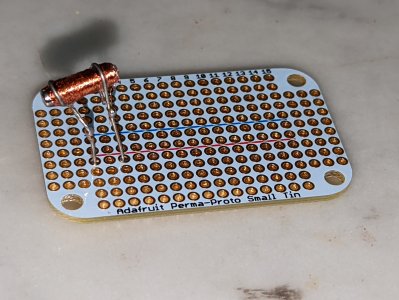Sadie-f
Senior Member
- Messages
- 427
(btw, best holiday wishes all!)
I've thought about this a good long time and partly because the pickups I would buy for a new build are for now on indefinite backorder (like 6 months +) .. time to think about doing it the hard way.
My aim is to build HB's with rare earth neodymium magnets, and I'm considering winding each pole piece individually.
Neo magnets are about 10x stronger, so I'd expect I can wind 10x fewer turns for the same signal at lower resistance and inductance.
Also, as I understand it, the closer the windings are to the pole pieces, the stronger the interaction, and so that ought to be an added benefit of both winding on a smaller core, and needing less total wire. In transformer calculation, we think of number of turns count, not total length of wire.
I'm not completely married to individually winding for each pole / string, however another potential advantage I see would be tailoring to the different output inherent to smaller / larger strings & wrapped vs bare as well.
Winding count is easy for me to setup, I've got plenty of stepper motors / controllers, so the only investment would be in a bobbin holder.
The potential downside I can imagine might be excessive brightness in the sound, I'm prepared to do some experiments to look at that, and working a single coil at a time, it would be pretty easy to gauge effect, both as qualitative and quantitative.
Thoughts?
I've thought about this a good long time and partly because the pickups I would buy for a new build are for now on indefinite backorder (like 6 months +) .. time to think about doing it the hard way.
My aim is to build HB's with rare earth neodymium magnets, and I'm considering winding each pole piece individually.
Neo magnets are about 10x stronger, so I'd expect I can wind 10x fewer turns for the same signal at lower resistance and inductance.
Also, as I understand it, the closer the windings are to the pole pieces, the stronger the interaction, and so that ought to be an added benefit of both winding on a smaller core, and needing less total wire. In transformer calculation, we think of number of turns count, not total length of wire.
I'm not completely married to individually winding for each pole / string, however another potential advantage I see would be tailoring to the different output inherent to smaller / larger strings & wrapped vs bare as well.
Winding count is easy for me to setup, I've got plenty of stepper motors / controllers, so the only investment would be in a bobbin holder.
The potential downside I can imagine might be excessive brightness in the sound, I'm prepared to do some experiments to look at that, and working a single coil at a time, it would be pretty easy to gauge effect, both as qualitative and quantitative.
Thoughts?



